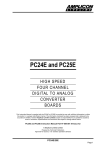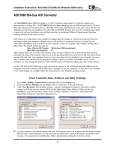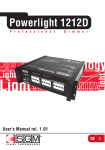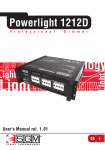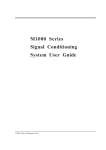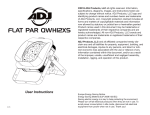Download Amplicon Liveline PC27E Instruction manual
Transcript
PC27E LOW COST 16 CHANNEL 12 BIT A/D CONVERTER BOARD This Instruction Manual is supplied with the PC27E to provide the user with sufficient information to utilise the product in a proper and efficient manner. The information contained has been reviewed and is believed to be accurate and reliable, however Amplicon Liveline Limited accepts no responsibility for any problems caused by errors or omissions. Specifications and instructions are subject to change without notice. PC27E Instruction Manual Part Nº 859 561 14 Issue A2 © Amplicon Liveline Limited Prepared by Technical Publications Approved for issue by A.S. Gorbold, Operations Director PC27E Page 1 DECLARATION OF CONFORMITY AMPLICON LIVELINE LIMITED CENTENARY INDUSTRIAL ESTATE HOLLINGDEAN ROAD BRIGHTON BN2 4AW UK We declare that the product(s) described in this Instruction Manual are manufactured by Amplicon Liveline Limited and perform in conformity with the following standards or standardisation documents: EMC Directive LVD Directive CE Directive 89/336/EEC 73/23/EEC 93/68/EEC Jim Hicks, I. Eng, FIEIE Managing Director Amplicon Liveline Limited Page 2 PC27E MODEL PC27E 16 CHANNEL 12-BIT A/D BOARD LIST OF CONTENTS PARA SUBJECT PAGE 1 1.1 1.2 GENERAL INFORMATION General Description Features 5 5 5 2 2.1 2.2 2.3 2.4 2.5 GETTING STARTED Installing the PC27E Requirements to Run the Software Backing up the Software Installing the Software on a Fixed Hard Disk DASH 27 Optional Software for the PC27E 6 6 6 6 7 7 3 SPECIFICATIONS 8 4 4.1 4.1.1 4.1.2 4.2 4.3 4.4 4.4.1 4.4.2 4.5 4.6 4.6.1 USER SETTINGS Board Base Address Factory Setting Customer Configured Base Address Input/Output Address Space used by the PC27E Interrupt Request Level Selection Counter/Timer Clock Selection Timing for A/D Conversions Frequency Measurement Wait State Generator Setting Input Voltage Range Setting Input Attenuators 8 8 8 8 9 9 10 10 10 11 11 12 5 5.1 5.2 5.3 ELECTRICAL CONNECTIONS User Connections EMC Considerations Main I/O Bus Backplane Connections 14 14 14 14 6 6.1 6.2 6.3 6.4 6.5 6.6 6.6.1 6.6.2 6.6.3 6.6.4 6.7 6.7.1 6.7.2 6.7.3 PROGRAMMING Windows DLLs and Visual Basic Example Programs Pascal Demonstration Program Copyright Programming the 82C53 Counter/Timers Programming the 7870 A/D Converter Programming Hints Multiplexer Settling Time Aliasing Inherent offset in Bipolar Mode Multiplexer Inputs Calibrating the PC27E Unipolar Calibration Bipolar Calibration ±2v Bipolar Calibration ±4v 15 15 16 16 17 18 19 19 19 20 20 20 20 21 21 LIST OF FIGURES PC27E Page 3 FIGURE TITLE PAGE 1 2 3 4 5 6 7 8 SW1 D.I.L Switch Selection for Base Address Connections to Counter/Timer Jumpers Connector SK1 Pin Designations Main Bus Backplane Connector Pin Assignments Analog to Digital Converter Output Code PC27E Block Diagram PC27E Printed Circuit Board Layout PC27E Circuit Diagram 9 10 14 15 19 22 23 24 LIST OF TABLES TABLE TITLE PAGE 1 2 3 Address Space Functions Settings for the Wait State Generator Analog Input Voltage Range Settings 9 11 11 APPENDICES Page 4 APPENDIX TITLE 82C53 Data Sheets on 82C53 Counter/Timer PC27E PC27E 16 CHANNEL 12 BIT DATA ACQUISITION BOARD 1. General Information 1.1 General Description The PC27E is a half sized plug in board which provides 16 channels of 12 bit, high speed analog to digital conversion. Integral sample and hold circuitry ensures stability during the conversion process. The PC27E board can be installed in the IBM PC/XT/AT, PS2 Model 30 and compatible computers. The flexible addressing system provided on the board allows the base address to be set within the range 000 to FF0 (hex). A comprehensive hardware facility allows selection of the interrupt levels IRQ2 to IRQ7 by jumpers. A 4MHz on-board oscillator provides an accurate source for the counter/timers, independent of the computer system clock frequency. The counter/timers can also be jumper configured to provide a frequency counter or events counter. Conversion can be initiated in 3 different ways: the counter/timer circuit can generate a precisely defined hardware interrupt conversion, a conversion can be directly initiated from an application program through software control, or an external TTL compatible signal can directly trigger a conversion. The end of conversion can be programmed to provide a hardware interrupt to the host system. 1.2 Features • 16 input channels. • 12 bit high speed A/D converter with integral sample and hold. • 10 µs total conversion time, typical. • 3 modes of converter triggering. • 3 independently programmable counter/timers. • On-board 4MHz oscillator. • Frequency counter function. • Flexible addressing and interrupt selection. • Wait state generation for compatibility with faster I/O bus speeds (optional). PC27E Page 5 2. GETTING STARTED The PC27E is supplied complete with Windows DLLs with Visual Basic example programs, and demonstration software written in Borland Turbo Pascal. The source code for the Turbo Pascal program is supplied and is compatible with version 4 and above. A copy of the language will be needed if the user wishes to edit the code. 2.1 Installing the PC27E Board ALWAYS SWITCH OFF THE POWER BEFORE INSTALLING OR REMOVING A DEVICE. If this is the first time that you have installed a peripheral card in the host computer, then please refer to the hardware manual supplied with the machine for instructions on how to remove the cover and install devices into the I/O channel expansion slots. The PC27E may be installed in any available slot in the machine provided that there is no restriction placed on that slot by the manufacturer of the machine. 2.2 Requirements to Run the Software The following software and hardware are required in order to enable you to run the Windows and DOS demonstration programs or the optional DASH 27 drivers (see 2.6 below): - An IBM PC, or compatible machine of another make. - Windows 3.1 or later. - 3 1/2 inch floppy disk drive. - Monitor. - PC27E fitted. - Suitable signal source 2.3 Backing up the Software It is important that a backup copy of the supplied disk is made, and the original stored in a safe place. The software can be copied onto another blank disk by using the MS-DOS command DISKCOPY A: A: on a single drive machine, or DISKCOPY A: B: on a dual drive machine. Always use the copy for your work. Page 6 PC27E 2.4 Installing the Software on a Fixed Hard Disk To install the software onto your hard disk, insert the diskette into drive A and select File|Run... from the Windows Program Manager, or if you are using Windows 95 select Run... from the Start menu. In the dialogue box that follows, type A:\SETUP <RETURN> The PC27E software setup program will now run. Follow the instructions given on the screen to complete the installation. See Section 6 ‘PROGRAMMING' for details on running the software. 2.5 DASH 27 Optional Software for the PC27E The optional DASH 27 software package (order code 908 919 58) is recommended for use with the PC27E. DASH 27 provides the following features:• QuickBASIC and Turbo Pascal Libraries • Source Code for the libraries • Averaging filter utility • FIR filter design utility • Two channel data plotting utility PC27E Page 7 3. Specifications Size of board 154mm x 100mm typically Typical Conversion time (including sample/hold settling time) Page 8 10µs Converter accuracy 12 bits + 1/2 LSB input ranges: Bipolar ± 2.0 Volts ± 4.0 Volts Unipolar 0 to + 4.0 Volts Input Impedance >100MΩ per channel Multiplexer plus input amp settling time <10µS. Cross talk between any 2 channels (at 1 MHz) better than - 50dB Oscillator accuracy ±0.3% Oscillator stability ±0.3% Power Requirements (From host PC) + 5 volts at 220 mA - 5 volts at 5 mA +12 volts at 5 mA -12 volts at 6 mA PC27E 4. USER SETTINGS 4.1 Board Base Address The PC27E can have its base address situated within the range Hex000 to HexFF0. This feature provides the flexibility to avoid any contention in I/O mapping that may arise with some clones and allows the use of multiple cards fitted in the PC expansion slots. 4.1.1 Factory Setting The board’s base address is set at the factory to be Hex300. 4.1.2 Customer Configured Base Address The board’s base address can be selected as any sixteenth address within the range Hex000 to HexFF0 by means of the appropriate settings of switch SW1. This switch bank comprises a row of eight single pole single throw switches with each ‘up’ or ‘ON’ position selecting a logic 0, and each ‘down’ or ‘OFF’ position selecting a logic 1. The most significant hex digit is coded by the four most left switches and the middle hex digit is coded by the four most right switches of SW1. Figure 1 below shows SW1 with the factory setting of Hex300. Most significant digit Middle digit Least significant Default 0011 = Hex3 0000 = Hex0 = Hex0 !""#$%" FIG. 1 SW1 D.I.L SWITCH SELECTION FOR BASE ADDRESS 4.2 Input/Output Address Space used by the PC27E The I/O Addresses of all the port registers used by the PC27E are shown in Table 1, where BA is the base address of the board (factory configured to HEX300). PC27E Page 9 &'' ' (!' !()%)%#"*+,%- !3 !()%)%#"*.+,%- !3 %#%/01#.0 !3 )%.#$% !3 .#(/)0%# !3 .#(/)0%# !3 !3 .#(/)0%# .#(/)0%#/0%#2#" !3 TABLE 1 ADDRESS SPACE FUNCTIONS 4.3 Interrupt Request Level Selection There are six Interrupt Request levels available on the PC27E, IRQ2 - IRQ7 with IRQ2 having highest priority and IRQ7 the lowest priority. The interrupt level is selected by the position of jumper J5, and, when selected, an interrupt will be sent to the 8259 interrupt controller inside the computer at that level on the falling edge of /BUSY from the A/D converter (ie at the end of a conversion - see section 6.4). 4.4 Counter/Timer Clock Selection 4.4.1 Timing for A/D Conversion The 4MHz on-board clock signal is used as the source for the Counter/Timer. Any one of the three outputs of the Counter/Timer can be connected to the /TIM input of the PAL. A falling edge of /TIM will trigger an A/D conversion. Jumpers J2, J3 and J4 may be positioned according to the required frequency of /TIM. The connections to these jumpers, showing the factory configuration, are given in figure 2. The 4MHz clock is the input to Counter 0, who’s output can be jumpered to /TIM or cascaded to the Counter 1 clock input, through Jumper J2 (see fig 2). If cascaded, the output of Counter 1 can be connected to /TIM, by positioning J3 in the upper position, or cascaded to the Counter 2 clock input by positioning J4 in the upper position. If cascaded the output of Counter 2 can be connected to /TIM by positioning J3 in the lower position. An external TTL compatible signal connected to SK1 pin 1 can be used as an alternative clock input to Counter 2 by positioning J4 in the lower position. 6 4 /5 4 4 6 6 4 ! 7$$ 6 FIG.2 CONNECTIONS TO COUNTER/TIMER JUMPERS Page 10 PC27E 4 /5 &( 4.4.2 Frequency Measurements A simple Frequency Counter can be implemented using the external frequency output on connector SK1 pin 1. The output of Counter 0 is inverted by QA12-B, and then fed to the gate of counter 2 by positioning jumper J7 to /OUT0 (upper position). Therefore Counter 0 controls the gate of Counter 2 and, if Counter 0 is programmed for Mode 2 (terminal count), a fixed-length gate pulse can be created for Counter 2. The external signal (of unknown frequency) can be connected to SK1 pin 1 and jumpered into the clock of counter 2 by positioning J4 in the lower position. If programmed to count down from HexFFFF, Counter 2 will count the number of external clock cycles during its gate pulse. Since the gate pulse is of known duration, the number of external clock cycles per second can be calculated, and hence the frequency. 4.5 Wait State Generator Setting (Option) The PC27E incorporates an on-board wait state generator (QA10) to enable it to operate reliably in a wide range of PC/XT/AT and ISA machines. The need for this is because some machines, that are otherwise IBM compatible, now operate the I/O expansion bus at clock frequencies higher than the 8MHz specified in the ISA standard. This option is not fitted as standard. Many interface ICs currently available cannot operate at these higher frequencies and it becomes necessary to slow down the bus interface signals, locally, on the PC27E board. The degree of retardation can be adjusted to give optimum performance in any machine. Being local to the PC27E board, this slowing down in no way impairs the performance of the host computer. The expansion bus frequency is not necessarily the same as that of the main processor clock. A computer which is specified as a 12 or 16 MHz machine could well have an expansion bus frequency of 8MHz. Unless explicitly stated in the machine specification there is no easy way to establish the speed of the expansion bus. If the expansion speed is known, then use Table 2 to set the appropriate number of wait states. If the bus speed is not known, it is suggested that the number of wait states is left at zero (No jumper). If the PC27E functions correctly leave the setting at zero wait states. If operation is erratic, increase the number of wait states. Introducing wait states can cause some machines to hang up, otherwise no harm can be done by setting the number of wait states too high, however the response of the PC27E board will not be optimum. 82! 9&! ! 4& 4%:; %:; %:; :;0"+1 664&' <)# 2 2 2 TABLE 2 SETTINGS FOR WAIT STATE GENERATOR PC27E Page 11 4.6 Input Voltage Range Setting The analog input voltage range can be set by the position of jumper J1. Table 3 shows the settings for the PC27E. J1 JUMPER POSITION UP BP No Jumper INPUT VOLTAGE RANGE PC27 0 to +4v -2 to +2v -4 to +4v TABLE 3 ANALOG INPUT VOLTAGE RANGE SETTINGS 4.6.1 Input Attenuators Although the PC27E has pre-defined input ranges, these can be modified on a channel by channel basis to allow higher or intermediate input voltages to be handled. This is accomplished by drilling out a link from the required channel and inserting appropriate resistors. Each channel is provided with a position for an input series resistor and single in-line resistor networks for two groups of eight channels. PLEASE NOTE. IF PROPERLY UNDERTAKEN, THESE MODIFICATIONS WILL NOT INVALIDATE THE WARRANTY. NO MODIFICATION SHOULD BE MADE TO A PC27E UNDER EVALUATION. RN2, RN3 QA5, QA7 INPUT MULTIPLEXERS SK1 Vin RN4, RN5 PC27E The links corresponding to each input channel are as follows, and can be located using the diagrams shown in figures 7 and 8, the printed circuit board layouts. Page 12 PC27E Channel Nº Input Pin SK1 0 1 2 3 4 5 6 7 8 9 10 11 12 13 14 15 4 5 6 7 8 9 10 11 12 13 14 15 16 17 18 19 Attenuator Resistor Positions Input Ground RN2 - A RN2 - B RN2 - C RN2 - D RN2 - E RN2 - F RN2 - G RN2 - H RN3 - A RN3 - B RN3 - C RN3 - D RN3 - E RN3 - F RN3 - G RN3 - H RN4 pin 2 RN4 pin 3 RN4 pin 4 RN4 pin 5 RN4 pin 6 RN4 pin 7 RN4 pin 8 RN4 pin 9 RN5 pin 9 RN5 pin 8 RN5 pin 7 RN5 pin 6 RN5 pin 5 RN5 pin 4 RN5 pin 3 RN5 pin 2 For example, to obtain a range of ±25 volts on analog input channel 0, while retaining ranging of ±2 volts on the other 15 channels: 1. Insert a single in-line resistor network in position RN4. 100kΩ would be a suitable value. (If only one channel is to be equipped with an attenuator, then a single 100kΩ resistor can be inserted between RN4 pins 1 and 2). 2. Drill out the drill point at RN2 - A using a 1mm drill, leaving the position clear to insert a resistor. 3. Calculate the required input resistor, Rin, thus:The maximum input voltage to the multiplexer must be ±2 volts for a full scale reading, with Vin ±25 volts maximum. Full scale reading ---------------------------------Maximum input voltage = Rin = ( (100k x ( Rin = (100k x 25/2 ) - 100k 100k --------------100k + Rin Maximum input voltage ) ----------------------------------- ) - 100k Full scale reading ) = 1.15MΩ 4. Insert a 1.15MΩ high stability resistor in the position vacated by drilling out RN2 - A. PC27E Page 13 5. ELECTRICAL CONNECTIONS 5.1 User Connections Inputs and Outputs to the PC27E are connected via a 37-way D socket on the PC27E card mounting bracket and marked SK1. Be careful to observe pin numbering. EXT CLK EXT TRIG AGND CHN0 CHN1 CHN2 1 20 2 21 3 22 4 23 5 24 6 25 7 CHN3 CHN4 CHN5 CHN6 CHN7 CHN8 CHN9 AGND AGND AGND AGND 26 8 27 9 28 10 29 11 30 12 31 13 32 14 CHN10 CHN11 CHN12 CHN13 CHN14 CHN15 GND GND AGND AGND AGND AGND AGND AGND AGND 33 15 34 16 35 17 36 18 37 19 AGND AGND AGND AGND AGND FIG. 3 CONNECTOR SK1 PIN DESIGNATIONS 5.2 EMC Considerations In order to maintain compliance with the EMC directive, 89/336/EEC, it is mandatory that the final system integrator uses good quality screened cables for external connections. It is up to the final system integrator to ensure that compliance with the Directive is maintained. Amplicon Liveline offers a series of good quality screened cables for this purpose. Please contact our sales staff. Page 14 PC27E 5.3 Main I/O Bus Backplane Connections Connection to the computer is made through the I/O channel main bus. The pin designations are shown in Figure 4, but for further information please consult the technical reference manual for the host computer. 62 Pin Connector (Pins B1 and A1 are at the bracket end of the board) S O L D E R S I D E Ground < + Reset < +5 Volts< +IRQ2/9* > -5 Volts < +DRQ2 > -12 Volts< -0WS < > +12 Volts< Ground < -SMEMW< -SMEMR< -IOW < > -IOR < > -DACK3< > +DRQ3 < > -DACK1< > +DRQ1 < > -DACK0< > CLK <> +IRQ7 < > +IRQ6 < > +IRQ5 < > +IRQ4 < > +IRQ3 < > -DACK2< > +T/C < +BALE < +5 Volts< OSC < Ground < B1 B2 B3 B4 B5 B6 B7 B8 B9 B10 B11 B12 B13 B14 B15 B16 B17 B18 B19 B20 B21 B22 B23 B24 B25 B26 B27 B28 B29 B30 B31 A1 A2 A3 A4 A5 A6 A7 A8 A9 A10 A11 A12 A13 A14 A15 A16 A17 A18 A19 A20 A21 A22 A23 A24 A25 A26 A27 A28 A29 A30 A31 < <> <> < <> <> <> <> <> < <> <> <> <> <> <> <> <> <> <> <> <> <> <> <> <> <> <> <> <> <> -I/O CHCK SD7 SD6 SD5 SD4 SD3 SD2 SD1 SD0 I/O CHRDY AEN SA19 SA18 SA17 SA16 SA15 SA14 SA13 SA12 SA11 SA10 SA9 SA8 SA7 SA6 SA5 SA4 SA3 SA2 SA1 SA0 C O M P O N E N T S I D E * Note: Pin B4 is IRQ2 for an XT Pin B4 is IRQ9 for an AT which is re-directed as IRQ2 FIG. 4 - MAIN PC BUS BACKPLANE CONNECTOR PIN ASSIGNMENTS PC27E Page 15 6. PROGRAMMING The PC27E is supplied with a 31/2 inch diskette containing Windows DLLs with Microsoft Visual Basic example programs, and a Borland Turbo Pascal DOS demonstration program. See Section 2.4 to find out how to install the software onto your hard disk. 6.1 Windows DLLs and Visual Basic Example Programs Having installed the software, you will find a number of Windows Dynamic Link Libraries (DLLs) each of which supports one basic Input/Output function available with the Amplicon low-cost Data Acquisition boards. Each DLL comes with a Visual Basic example program, and all the source files for these Visual Basic programs are provided. Any number of these programs can be run concurrently to build up the system represented by one or more of the boards being used. The default installation for the PC27E creates four new icons in the ‘Amplicon Introductory DLLs’ folder/Program Manager group: AD27DEMO TC53DEMO README AMPLICON LIVELINE LTD - Visual Basic analog input demo program - Visual Basic timer/counter demo program - User Guide for the Amplicon Introductory DLLs - What Amplicon offers you To open any of these objects, simply double-click the mouse on the relevant icon. For more information on the functions provided by the DLLs, and how to use them in your own Visual Basic Windows programs, please read the User Guide by double-clicking on the README icon. 6.2 Pascal Demonstration Program Two Turbo Pascal files are also installed into the Introductory DLL directory: PC27.PAS PC27.EXE (source code) (executable) To run the program log on to the disk drive or directory containing the software and type PC27 <RETURN>. On running the program, the screen lists a menu from which the required demonstrations can be selected. The menu items comprise: 1. Change PC27E base address (Default 300Hex) 2. S/W controlled sampling on one channel only 3. S/W controlled sampling on 16 channels 4. Interrupt controlled sampling on one channel only 5. Interrupt controlled sampling on 16 channels 6. External trigger controlled sampling on one channel Page 16 PC27E 6.3 7. Frequency Counter 8. EXIT to DOS Copyright The software on the demonstration disk is copyright Amplicon Liveline Ltd. Any user who has purchased a PC27E may use the software, or any part of it, for use in his own programs, or for resale when delivered with a PC27E. 6.4 Programming the 82C53 Counter/Timers The three counter/timers of the 82C53 can be independently programmed to operate in any one of six modes. These are: 1. Mode 0: Interrupt on Terminal Count. 2. Mode 1: Programmable One Shot. 3. Mode 2: Rate Generator. 4. Mode 3: Square Rate Generator. 5. Mode 4: Software Triggered Strobe. 6. Mode 5: Hardware Triggered Strobe. Details of the operation of these various modes are contained in Appendix 82C53. The function of a particular timer/counter is established by writing a control word to the control register. This 8 bit word consists of four fields as follows: D7 D6 Select Counter D5 D4 Read/ Load D3 D2 D1 Select Mode D0 = 0: binary selected. = 1: BCD selected. D3,D2,D1 = 0 0 0: Mode 0 selected. = 0 0 1: Mode 1 selected. = 1 0 1: Mode 5 selected. D5,D4 = 0 0: Latch Counter. = 0 1: Read/Load of LSB only = 1 0: Read/Load of MSB only = 1 1: LSB followed by MSB D7,D8 = 0 0: Counter 0 selected. = 0 1: Counter 1 selected. = 1 0: Counter 2 selected. = 1 1: Prohibited combination. PC27E D0 BCD or Binary Page 17 Example 1 To select Counter 1 to Mode 3, loading/reading low order byte followed by high order byte in binary, the control word is: 0 1 1 1 0 1 1 0 = 76 hex This value has to be loaded to the control register whose address is Base Address + 07. Assuming that the board base address is 0300, the following BASICA or QuickBASIC statement will load the control register with 76 hex. OUT &H0307, &H76 The value of the count has now to be loaded to the counter. The address of Counter 1 is base address +05 which, in our example would be 0305. To load the value 50 decimal to this counter the Turbo Pascal statements Port[$305] := $32; Port[$305] := 0; are used. It should be noted that both the low order and high order bytes have to be loaded even though the high order byte, as in the above example, is zero. Example 2 To read the current count on Counter 1 without affecting the counting operation the counter has to be latched. To do this the control word 0 1 0 0 0 1 1 0 (46 hex) is loaded to the control register by OUT &H0307, &H46 The two bytes then have to be read from the latch using the command n = INP( &H0305 ) to read the low order byte followed by n = INP( &H0305 ) to read the high order byte. The two bytes MUST be read before attempting to execute another OUT instruction on the same counter. 6.5 Programming the 7870 A/D Converter There is no need for software programming of the A/D mode since the operational conditions are set up in the hardware on the PC27E. The 7870 is wired for Mode 1 operation, with parallel output format in two bytes. A conversion is initiated by a low going pulse on /CONVST, which is generated by the PAL whenever START (BA +2 write) is addressed. At the end of a conversion /BUSY goes low, generating an IRQ, if selected. A read operation to the 7870 accesses the data and the /BUSY line is reset high again. To access the data, two read operations are required. The HBE pin selects which byte of data is to be read; when low (BA+0 read) the lower 8 bits are placed on the data bus, when high (BA + 1 read) the upper 4 bits of the 12 bit word are placed on the data bus. These 4 bits are right justified and thereby occupy the lower nibble of the data byte, while the higher nibble contains zeros. Page 18 PC27E The 12 bit data word is not coded in pure binary, but in a form of 2s complement where the most significant bit is inverted. The transfer functions for bipolar and unipolar operation are given in figure 5. N.B. Under software sampling it is not possible to detect the status of each sample, so the user must insert a delay between starting the conversion and reading the first byte, typically >10µs. 4 & 4 / ===> ===> ===> ===> >( ===> ===> ===> ===> ===> *3(> - .# #0A# )0$%.0 ?(@ 1 &47! ?(@ 4 & 4 / ===> ===> ===> ===> ===> ===> ===> ===> 1 40.# #0A# )0$%.0 3> &47! FIG. 5 ANALOG TO DIGITAL CONVERTER OUTPUT CODE 6.6 Programming Hints 6.6.1 Settling Time of Input Stages When switching to another analog input channel, the settling time of the multiplexer plus the amplifier stages is less than 10 µSecs to within 0.1% of full scale. As the A to D Converter incorporates a sample and hold circuit, careful programming can allow the analog settling time to overlap A to D conversion time for maximum throughput. PC27E Page 19 6.6.2 Aliasing Never try to sample a signal at a rate less than or equal to twice the signal frequency. Otherwise distortion known as aliasing will arise where the frequency of the sample data will appear to be much less. Aliasing is illustrated in the following diagram. &4 ! !& @ ! ! ! 6.6.3 Inherent Offset in ±4 Volt Bipolar Mode There is no facility to adjust the offset to zero in ±4 volts, bipolar mode. This gives rise to a possible offset error of a few millivolts on this range. If necessary the offset could be compensated in software by subtracting the offset value from each sample data. 6.6.4 Multiplexer Inputs Please note that all unused analog input channels must be grounded. The maximum signal voltage applied to any multiplexer input must not exceed ±5 volts. 6.7 Calibrating the PC27E 6.7.1 Unipolar Calibration 1. Run the PC27E Pascal demonstration program 2. From the main menu, press 2 to select Software Controlled sampling on one channel only . 3. Enter 1 for unipolar Input and confirm. 4. Enter 1 for the channel number. (Note in the Pascal demo program, the channels are numbered 1 to 16). Page 20 PC27E 6.7.2 6.7.3 5. Ensure jumpers J1 to J7 are correctly positioned according to the table on the screen. 6. Connect a precision voltage source between SK1 Pin 4 (positive) and Pin 22 (negative), and ground the unused channels by connecting SK1 Pin 5 to Pin 23, Pin 6 to Pin 24, Pin 7 to Pin 25,..... Pin 19 to Pin 37. 7. Set the voltage source to +0.97mV and adjust RV2 until data reading is 2048-2049. 8. Set the voltage source to +3.999 and adjust RV1 until data reading is 2046-2047. 9. Repeat 7 and 8 if necessary. Bipolar Calibration ±2 volts 1. Run the PC27E Pascal demonstration program. 2. From the main menu, press 2 to select Software Controlled sampling on one channel only. 3. Enter 3 for Bipolar input (± 2 volts) and confirm. 4. Enter 1 for the channel number. (Note in the Pascal demo program, the channels are numbered 1 to 16) 5. Ensure the jumpers J1 to J7 are positioned according to the table on the screen. 6. Connect a precision voltage source between SK1 Pin 4 (positive) and Pin 22 (negative), and ground the unused channels by connecting SK1 Pin 5 to Pin 23, Pin 6 to Pin 24, Pin 7 to Pin 25,..... Pin 19 to Pin 37. 7. Set the voltage source to -1.988 and adjust RV2 the data reading on the screen is 2048/2049. 8. Set the voltage source to +1.998 and adjust RV1 until the data reading on the screen is 2046/2047. 9. Repeat 7 and 8 if necessary. Bipolar Calibration ±4 volts 1. Run the PC27E Pascal demonstration program. 2. Select Software Controlled sampling on one channel only. 3. Enter 2 for Bipolar input (+ 4V) and confirm. 4. Enter 1 for the channel number. (Note in the Pascal demo program, the channels are numbered 1 to 16) 5. Ensure the jumpers J1 to J7 are positioned according to the table on the screen. 6. Connect a precision voltage source between SK1 Pin 4 (positive) and Pin 22 (negative), and ground the unused channels by connecting SK1 Pin 5 to Pin 23, Pin 6 to Pin 24, Pin 7 to Pin 25,..... Pin 19 to Pin 37. PC27E Page 21 7. Set the voltage source to +3.998 and adjust RV1 until the data reading on the screen is 2046/2047. 8. Set the voltage source to -3.988 and check the data reading on the screen is 2048/2049. (N.B No offset adjustment in Bipolar ±4v - see 6.5.3). 'B / 1 'B% .% & / ' ! / !% /7'' !! 4' .% 4 > &9' /:! !! &4 '!!! 4 )%.#!""# &! /' '/' ,/D ! !' / :; / /:'C /4' ' &/ !""# .% 9 /5 2! ! '!' FIG. 6 PC27E BLOCK DIAGRAM Page 22 /01#.0 /0%# % /0%# ! ! &!' C PC27E 9' FIG. 7 PC27E PRINTED CIRCUIT BOARD LAYOUT PC27E Page 23 FIG. 8 PC27E CIRCUIT DIAGRAM Page 24 PC27E
























